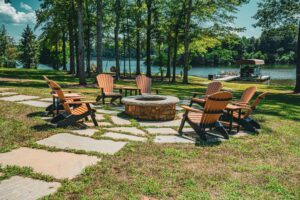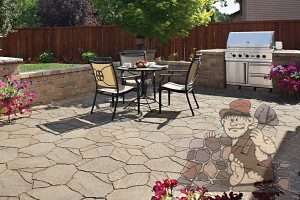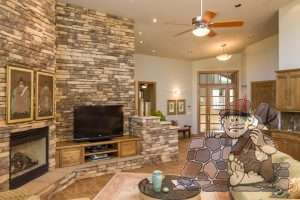The environmental movement has made its way into landscaping design and we are not just talking about the color. Integrating hardscaping into your landscape design is environmentally friendly. It might sound contradictory but most successful “green” landscapes blend the living environment with hardscaping elements.
Green landscaping is a term referring to a landscape that is designed and maintained to save time, money, and energy. It is also known as sustainable landscaping or eco-landscaping. When designed to blend the living environment with hardscape elements, green landscapes benefit wildlife and provide healthy outdoor spaces.
Choosing a sustainable material, finding ways to minimize negative environmental impact, and reducing maintenance are all factors that help make working with natural stone ideal choices for green landscaping.
Sustainability
One of the most durable and versatile sustainable materials for hardscaping is natural stone. Stone can be used for a garden structure, gravel pathway, paved patio and walkway, rock retention wall, and so forth. Because it is durable, stone does not require long-term labor to maintain once it has been placed in the landscape. This saves time and money. It also helps with drainage to conserve water and soil retention to minimize erosion.
Minimal Environmental Impact
Hardscape materials such as natural stone are low-impact and low-input, meaning they minimize the input of resources and the output of waste. Materials such as natural stone don’t contain harsh chemicals like asphalt, aren’t environmentally complex like concrete, and don’t need to be topped off each season like mulch. They don’t need fertilizers, pesticides, and herbicides. By reducing or avoiding chemicals, using natural stone in hardscaping is better for us, the wildlife, and the environment.
Low Maintenance
Hardscaping can help reduce your maintenance by replacing areas where plants are hard to grow and reducing the need for watering where you lessen your lawn with alternate surfacing. Many stone pavers have naturally high permeability rates so water can flow through them instead of as run-off. This makes them ideal for paths, driveways, patios and pool decks. Besides conserving water, another benefit of reducing lawn or hard-to-grow areas by hardscaping is you don’t have to continuously mow, weed, seed, or otherwise waste your time and energy maintaining the area.






